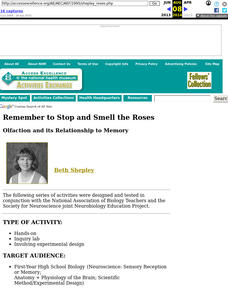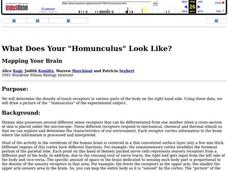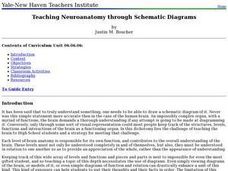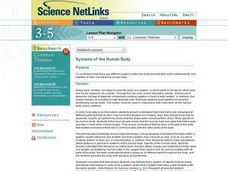Curated OER
Protection, Support, and Locomotion
In this skeletal system worksheet, students will read a graphic organizer and complete 1 short answer question about the five functions of the skeleton. Then students will use a graphic organizer about muscle types to fill in a table...
Curated OER
Basic Units of Life
For this cells worksheet, students will review vocabulary words and information relating to the structure and function of plant and animal cells. This worksheet has 10 crossword puzzle questions, 6 multiple choice, 4 short answer...
Curated OER
Protection, Support, and Locomotion
In this vertebrate skeleton worksheet, middle schoolers will read a paragraph about the function of bones, muscles, and skin. Then students will complete 6 short answer questions.
Curated OER
Human Body Systems: The Domino Effect
Students create a domino course to represent different human body systems. They discover the systems relationship to each other and their functions. They answer questions to complete the lesson.
Curated OER
The Sense of Hearing
High schoolers study the cycle of how we listen and hear our own speech. They examine sound waves, and the role of the nervous system in hearing. They investigate the cues besides lipreading that deaf people rely on for comprehension.
Curated OER
Remember to Stop and Smell the Roses: Olfaction and its Relationship to Memory
Students discover that olfaction elicits memory associations. They investigate how olfaction compares to other sensory modalities in the formation of memories. This is a hands-on lab activity guaranteed to build memories in your students!
Curated OER
What Does Your "Homunculus" Look Like?
Students investigate the density of touch receptors in various parts of the body. They discover how the body senses various stimuli, then maps a picture of the "homunculus" of the experimental subject.
Curated OER
Health-Nervous System Review
In this nervous system instructional activity, students are given seventeen clues about structures of the nervous system and they put their answers in a crossword puzzle.
Teach Engineering
Complex Networks and Graphs
Show your class how engineers use graphs to understand large and complex systems. The resource provides the beginnings of graph theory by introducing the class to set theory, graphs, and degree distributions of a graph.
Curated OER
Teaching Neuroanatomy through Schematic Diagrams
Students identify the parts and function of a neuron. They explain and illustrate the levels and functions of the nervous system including neurons and the Central and Peripheral Nervous Systems. They analyze and diagram the Lobes and...
Curated OER
Investigating Osmosis
A thorough investigation of cell transport is provided when completing the assignment. The first half requires biology class members to answer questions about diffusion and osmosis with the aid of diagrams. Then they fashion an...
Curated OER
The Nervous System
In this nervous system worksheet, students review the structure and function of the central nervous system. This worksheet has 1 drawing and 17 fill in the blank statements.
Curated OER
Central Nervous System Study Questions
In this central nervous system worksheet, learners define 24 terms associated with the human central nervous system. They answer 28 short answer questions dealing with the structures and function of the CNS.
Curated OER
The Nervous System Lesson
Students identify features of the nervous system. They explore the needs of the human body by explaining the importance of good health in relationship to the body and explain the functions and care of the human body and its organs.
Curated OER
Neuron Creations
Students examine neurons. In this nervous system lesson, students build models of neurons in order to study their parts and functions.
Curated OER
Special Senses
In this special senses worksheet, 9th graders briefly describe the structure of a taste bud and the pathway a signal takes to the brain. Then they list the five basic taste sensations and homeostatic values of taste. Students also...
Curated OER
Teen and Decision Making
Students examine how the brain develops. In this neurology lesson students read an article citing evidence that the different areas of the brain mature at different rates. They discuss emotional versus logical aspects of decision-making....
Curated OER
Levels of Organization
Students brainstorm a list of all the functions organisms carry out and how they carry them out. In groups, they are given the smallest and highest level of organization in organisms and are to fill in the missing spaces. To end the...
Curated OER
It's All in Your Mind
Pupils investigate the definition of memory. In this memory lesson students investigate strategies to improve memory as well as examine what the difference is between a short-term memory and a long-term memory.
Curated OER
What is the Anatomy of the Visual System?
Students research the structures and functions of the eye. In small groups they dissect a model of the human eye, identify structures of the eye, and describe the functions of the photoreceptors.
Curated OER
Show 303: New Research into Dyslexia
Students explore the causes of dyslexia. They view CT sans and MRIs to view the brain and how it responds. Students read reports about dyslexia. They discuss the nature of dyslexia, its cause, how to diagnose it, and its permanency.
Curated OER
Healthy Eyes and Low Vision Care
Students explain how eyes function, how to prevent eye problems, the types of refractive errors, and the common low vision and eye disease problems. They receive professional development points upon successful completion of an assessment.
Curated OER
Oh, Say Can You See
Students explore different parts of the eye and functions of each part through a video and a dissection of a cow's eye. They discover different causes of blindness.
Curated OER
Biology: Systems of the Human Body
Students examine the different systems of the human body and how they work independently and cooperatively. They complete sevral online interactive projects designed to reinforce how the systems work alone and together. Students make...























